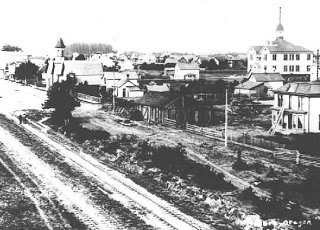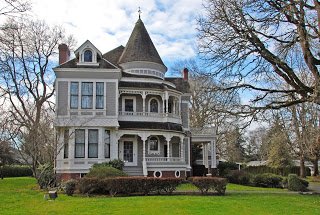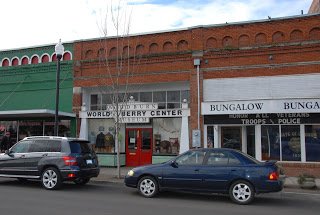 |
| Front Street Woodburn, 1893 |
The directions lay beside me on the car seat as I drove to my appointment in Woodburn. At the intersection, turn right, then left at the stoplight and so on. But still, I became lost. The driver of a trash truck was sympathetic and told me how to find my destination. I had taken I-55, not 99E, and so reversed the intended route. No matter which road one takes, Woodburn is hard to find. It nestles between the highways along the north-south railroad track that remain the heart of the city.
The rail lines created Woodburn, even, according to one theory, gave its name. Originally the town and its station were called Halsey, but the name was changed due to the existence of another town of the same name further down the valley. The name Woodburn may have come about after a slash burn that got out of control and burned down a woodlot near the railroad line. Engine 1785 on Front Street between Cleveland and Young (on the east side of the railroad track) belongs to the city and is a symbol of Woodburn’s railroad past.
Salem’s Capitol Journal newspaper took notice of Woodburn during its early history:
1896: A whole block was destroyed by fire. Combustion started in the drug store of L. Guise when gasoline ignited and quickly spread to adjacent buildings. Woodburn, despite its name, had no fire department.
1902: A grand union temperance meeting was to have been held here. But on account of so many temperance people being engaged in picking hops, the meeting was postponed.
1913: Mr. and Mrs. John Steelhammer left Woodburn for Salem with their two children in the back seat of their car. While jolting over a bad piece of road, John, Jr. was thrown out of the car and onto the road. Four miles further along the road the child was missed. Steelhammer instantly turned the car around and in great apprehension speeded back toward Woodburn. After driving three miles, he found his son running toward the car, laughing and uninjured.
1928: Rosalina Keber, Capitol Journal’s society editor, interviewed Mrs. Charles Bickner, a recluse living on a seven-acre plot in Butte Creek canyon [3 miles east of Woodburn]. Mrs. Bickner had not yet heard a radio or Victrola and had seen but a single automobile. Entry into Mrs. Bickner’s cabin revealed a stove without a pipe. When she started a fire, she just opened a window and let the smoke blow out.
1930: City Council expressed concern about transients who entered the jail to escape inclement weather and proceeded to burn up the wood supply while there.
(See “Ben Maxwell’s Salem, Oregon,” edited by Scott McArthur, 2006):
Such items as these reflect a small-town community life that is hard to imagine today. It was a pleasant surprise for us to discover that nostalgic Woodburn. It is in the neighborhood of the still-used Front Street railroad track. Near here one finds the new City Hall (the lobby decorated with many historic photographs), the fine library adjacent to the original 1914 Carnegie building and quiet residential avenues in gracious, historic neighborhoods. In that atmosphere, it is hard to remember that Woodburn is the third most populous area in the county after Salem and Keizer, a city of 5.4 square miles and home to 24,080 residents. Although Woodburn is the center of commerce and service for North Marion County, it is in transition as defined in The New Pluralism in Woodburn, Oregon, a summary report written by Ed Kissam with Lynn Stephen, 2006. This changes include the decline in agribusiness (now less than 20% of local business payrolls), the “graying of America” resulting in the growth of spacious retirement projects, emergence of “ex-urban bedroom community” and diversity within itself of the immigrant population.
May ~ Cinco de Mayo
July – August, Summer Nights Concerts in the City Plaza
August ~ Fiesta Mexicano
October ~ great Pumpkin Weight-Off
Year round ~ visits to nationally recognized nurseries and to boutique wineries
For heritage tourists, there are three National Register Historic Properties: the Bank of Woodburn, 199 N Front Street; Old Woodburn City Hall, 550 1st Street and the Jesse Settlemier House, 355 N Settlemier Avenue (503 982 1897) Open 1st Sunday of each month, 1-4 pm with a fee of $5. During a tour through the Settlemier residence, the guide will recall for you both the joys and tragedies of that family’s life there.
The Woodburn World Berry Center, a historic museum at 455 North Front Street, is open Fridays and Saturdays, 11-3 pm. It is the best museum in the county, representing not just this Oregon community, but a small town America all senior citizens can identify: “Oh, yes! I remember that,” I said dozens of times wandering around the displays. Don’t miss it.
This is a city that deserves more than a visit to shop at a discount-shopping complex. Two websites offer invitations to current community events, one maintained by the city and another by the area Chamber of Commerce. The Chamber sums up the way we feel about visiting Woodburn: Always Fresh Discoveries!
Each Tuesday, after a city was featured in that Sunday’s Statesman Journal, KMUZ broadcasted “Marion County 20”. To learn more about Woodburn, listen to the podcast listed on the KMUZ website archives.


